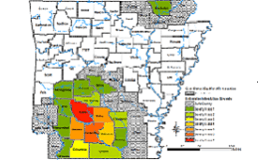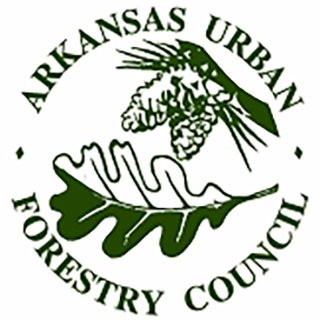Emerald Ash Borer in AR
- At August 23, 2017
- By Julie Robbins
- In Uncategorized
 0
0

The emerald ash borer (Agrilus planipennis; EAB) is considered the most costly and destructive invasive forest insect in the United States, killing nearly every ash tree (Fraxinus spp.) encountered. EAB is native to northeastern China, eastern Russia, Japan, and the Korean peninsula. Within its native range, EAB functions as a secondary colonizer killing stressed and declining trees. In North America, EAB was first detected and introduced in Detroit, Michigan. EAB larvae feed on the phloem and cambium of infested trees disrupting nutrient and water transport ability. Currently, EAB is confirmed in 17 Arkansas counties with a total of 33 counties under quarantine (Figure 1). Detection surveys will most likely confirm additional counties before the end of the year.
Host: Susceptible hosts include all species of ash, including green ash (F. pennsylvanica), white ash (F. americana), pumpkin ash (F. profunda), Carolina ash (F. caroliniana), and blue ash (F. quadrangulata). Green and white ash are the most common in Arkansas. White fringetree (Chionanthus virginicus), a native and an ornamental is also a suitable host.
Symptoms: Adult beetles are iridescent green and are between 7.5 to 13 mm long. When wings are open, purple abdominal segments are shown. Adults emerge at the end of March continuing through July and can be seen resting or feeding on tree boles and leaves. In severely infested trees, S-shaped larval galleries can be found under the bark. These galleries are packed with frass and widen with larval growth. Galleries end in shallow chambers used by prepupae over winter. EAB larvae are creamy white, legless, with bell-shaped body segments-last segment has pincer-like appendages. Infested ash trees initial symptoms include crown dieback and epicormic branching on the main bole followed by bark splits, woodpecker feeding holes, basal sprouting, and D-shaped exit holes on the main trunk.
Conditions: Availability of host material seems to be the only limiting factor of EAB distribution and spread. EAB attacks healthy and stressed trees, although stressed trees are preferred. Trees as small as 1 inch in diameter are colonized, and foliage feeding by EAB adults occurs but causes minor defoliation. Open grown ash trees, such as yard and urban trees, are preferentially targeted by EAB adults.
Management: The current imposed quarantine encompasses 33 counties and prohibits the movement of quarantined items, such as hardwood firewood and ash nursery stock, green lumber, and other living or cut material, outside of the quarantine area. Contrary to common belief, several management options are available to protect ash trees and manage EAB populations. A wide variety of insecticides are currently available to protect valuable ash trees effectively for multiple years. In fact, insecticide treatments were shown to be more economical than ash tree removal in urban settings. Treatments when trees are still healthy or at the onset of infestation are most prudent as most insecticides act systemically. Within EAB confirmed counties, insecticide treatments should begin when infested spots are within 10-15 miles of the area of interest. In Arkansas, ideal treatment times are the last week of March and the first two weeks of April. Removal and replacement of ash trees is an alternative. Ash tree wood is valued for many uses including hand tools and baseball bats and it is prudent to utilize the wood resulting from removal operations. Please report signs and symptoms of EAB to Arkansas State Plant Board and for more information refer to www.emeraldashborer.info or www.arinvasives.org
By Mohammad Bataineh, Assistant Professor of Forest Health, Arkansas Forest Resources Center, (870) 460-1449, Bataineh@uamont.edu




